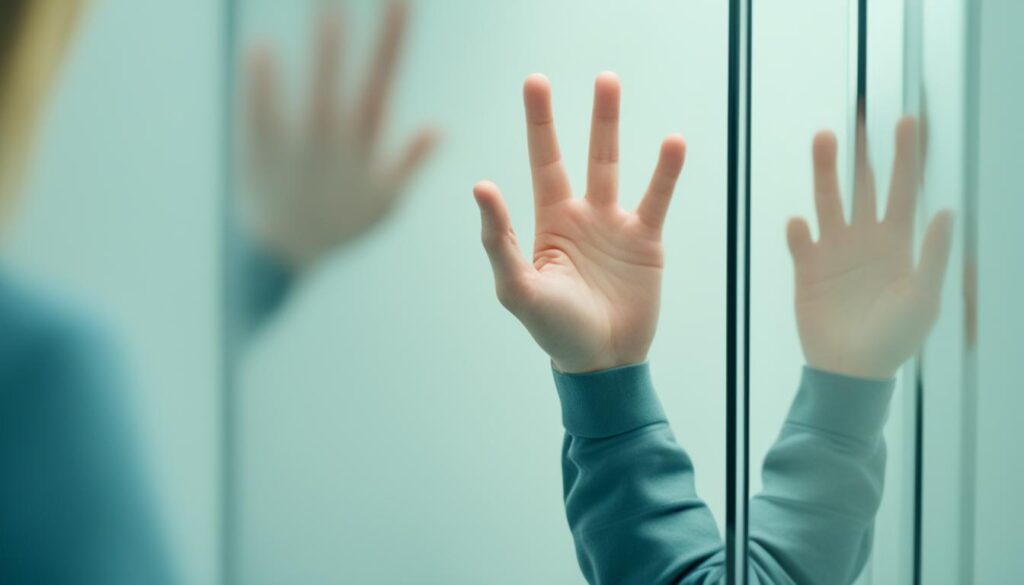Have you ever been in a dream and knew you were dreaming? That’s when you can shape the world around you. I remember my first lucid dream well. I was falling from a skyscraper, feeling scared, when I realized it was just a dream. Then, I spread my arms and flew like a superhero. That’s the magic of lucid dreaming.
Lucid dreaming is real and can be learned. It opens doors to creativity, solving problems, and growing personally. You can practice your golf swing or speak in public while you sleep! Some people even bring skills from dreams into their waking life, like in martial arts1.
But, not many people have lucid dreams. About half try them, but only 20% have them often, and just 1% have them a lot2. That’s why learning how to control and manipulate dreams is so important. It’s like having a superpower many don’t get to use.
Are you ready to explore dream awareness and unlock your mind’s potential? Let’s learn how to be the master of our dreams. We can turn our nights into adventures with no limits.
Key Takeaways
- Lucid dreaming lets you control and change your dreams
- About half of people try lucid dreaming
- Controlling dreams can boost creativity and problem-solving
- Skills learned in lucid dreams might work in real life
- Getting good at dream control takes effort and focus
Understanding Lucid Dreaming
Lucid dreaming is when you know you’re dreaming while asleep. This special state lets you control your dreams. Let’s explore the science, benefits, and uses of lucid dreaming.
What is lucid dreaming?
Lucid dreaming means knowing you’re dreaming while you sleep. This lets you shape your dreams. About half of people have had a lucid dream at least once. About 11% have one or two each month3. In a survey of 3,427 people in Brazil, 77% said they had a lucid dream3.
The science behind lucid dreams
Lucid dreams happen in REM sleep, with fast eye movements and lots of brain activity. The part of the brain that thinks about thinking gets more active. This lets you know you’re dreaming and control it.

Benefits of mastering dream control
Learning to control your dreams has many benefits:
- It can help with nightmares that bother your life3.
- It might ease anxiety, PTSD, depression, and stress4.
- It could improve skills, helping people with disabilities or in rehab4.
- It can be therapy for phobias, like fear of flying or spiders3.
To try lucid dreaming, keep a dream journal and practice mindfulness. These can help you remember and control your dreams. But, be careful with lucid dreaming. If you have sleep problems, talk to a professional453.
Techniques to Control and Manipulate Dreams
Dream control techniques let you shape your dreams. Reality checking is a simple yet powerful way. It means asking yourself if you’re dreaming all day. This helps you know when you’re dreaming, so you can control it6.
Wake-initiated lucid dreaming (WILD) is another good method. It lets you go straight into a dream state while staying awake. You need to relax and focus on your breathing as you fall asleep7.

Dream incubation is cool. You think about a specific dream before you sleep. This can change your dreams and help solve problems. In one study, a quarter of people solved problems using this method8.
The Mnemonic Induction of Lucid Dreams (MILD) method involves saying a mantra before sleep. It helps you stay aware in your dreams. Using MILD with Wake Back to Bed (WBTB) makes controlling dreams better7.
| Technique | Description | Effectiveness |
|---|---|---|
| Reality Checking | Questioning reality throughout the day | Simple and highly effective |
| WILD | Transitioning directly to dream state | Very effective but challenging |
| Dream Incubation | Visualizing scenarios before sleep | Useful for problem-solving |
| MILD | Reciting mantras before sleep | Effective when combined with WBTB |
Mastering dream control takes time and patience. Start with reality checking and try other methods to fully enjoy your dreams.
Reality Testing for Dream Awareness
Reality testing boosts your metacognition and dream awareness. It makes you question reality, even in dreams. By checking your surroundings often, you train your mind.
Common reality checks
Reality checks challenge dream physics and logic. Try these popular methods:
- Examine your hands: Look for extra fingers or unusual details
- Check mirrors: Your reflection might be distorted or missing
- Push against solid objects: In dreams, your hand might pass through
- Read text or digital clocks: Text often changes when you look away and back
- Attempt to breathe while pinching your nose: In dreams, you might still breathe
Studies show that regular hand checks make lucid dreaming 45% more likely9.
Developing a reality testing habit
Consistency is key for effective reality checks. Set reminders to check throughout the day. This trains your brain to question reality, even in sleep.

A survey found mirror checks daily increased lucid dreams by 50%9. Combining reality checks with journaling boosts lucid dream rates by 70%9.
Using reality checks in dreams
Reality checks in dreams may fail in strange ways. This failure can make you realize you’re dreaming. Research shows early morning checks are 60% more successful9.
Mastering reality testing helps you recognize dream signs and become lucid. Remember, practice and persistence are key to this skill. They unlock your dream potential.
| Reality Check Method | Success Rate | Best Time to Perform |
|---|---|---|
| Hand Examination | 45% increase in lucidity | Throughout the day |
| Mirror Check | 50% increase in lucid dreams | Morning and evening |
| Time Check | 60% higher success rate | Early morning hours |
Mnemonic Induction of Lucid Dreams (MILD)
The MILD technique was made by Dr. Stephen LaBerge. It’s a strong way to start lucid dreaming. It uses your mind to remember and set goals for dream recognition10. Studies say 55% of adults have had a lucid dream, and 23% do it often11.
MILD means waking up while sleeping, remembering a dream, and spotting a “dreamsign”. Then, you aim to see this sign in future dreams. This helps you remember and understand your dreams better.

- Wake up during your sleep cycle
- Recall a recent dream
- Identify a dreamsign
- Set an intention to recognize the dreamsign
- Repeat a phrase like “I’ll remember I’m dreaming”
- Fall back asleep with this intention
Using MILD with the Wake Back to Bed method works best. People who did this and fell asleep quickly had lucid dreams 45.8% of the time11. For great results, do MILD right after waking from a dream and before sleeping again10.
“The next time I dream, I want to remember that I am dreaming.”
Reality checks are key to lucid dreaming. You can check by testing your breathing, jumping, reading, or checking your hands. These checks differ in how well they work, how fast, and if they’re easy to notice12. Doing reality checks during the day can help you dream lucidly.
| Reality Check | Reliability | Speed | Inconspicuousness |
|---|---|---|---|
| Breathing | High | Fast | Medium |
| Jumping | Medium | Medium | Low |
| Reading | High | Slow | High |
| Hand Examination | Medium | Fast | High |
Mastering MILD and reality checks can boost your memory and dream recall. With practice, you can control and shape your dreams. This opens a world of endless possibilities.
Wake Back to Bed (WBTB) Method
The Wake Back to Bed (WBTB) method is a great way to start lucid dreaming. It means waking up during your sleep cycles to boost your chance of entering a lucid dream state.
Timing your wake-up
For the best results, wake up 5-6 hours after bedtime. This is when most dreaming happens. Waking up then can help you have lucid dreams later13.
Activities during wakefulness
Stay awake for 20-30 minutes after waking. Do things that keep you alert but aren’t too exciting. Reading about lucid dreaming, doing reality checks, or meditating helps. This short time awake keeps your brain active, making it easier to stay aware when you sleep again13.
Returning to sleep with intention
When you go back to bed, think about becoming lucid in your dreams. Say a simple phrase like “I will recognize I’m dreaming” as you fall asleep. This helps you become more aware in your dreams.
Using WBTB with other methods like MILD can work well. Studies show it can lead to lucid dreams in a week with regular practice13. But remember, waking up during sleep can affect your sleep quality. So, use this method carefully14.
| WBTB Step | Duration | Purpose |
|---|---|---|
| Initial Sleep | 5-6 hours | Align with REM cycle |
| Wakefulness | 20-30 minutes | Increase alertness |
| Return to Sleep | Remainder of night | Enter lucid dream state |
Conclusion
Learning how to control and manipulate your dreams can open up a new world. You can make choices and control what happens in your dreams. This can help improve your problem-solving skills and make complex puzzles easier15.
This world of dreams has caught the interest of both philosophers and scientists. They wonder about the nature of reality and what dreams mean16.
Lucid dreaming has many benefits, but it’s important to be careful. There are different methods like MILD, WBTB, and reality testing to help you have lucid dreams. But remember, it takes time and effort15.
Dreams can be hard to predict or study because they are very personal. So, be patient as you try to control your dreams17.
When you start to control your dreams, remember they can do more than just entertain you. They can help you practice social skills, solve emotional problems, and even help you remember things better17.
By getting better at lucid dreaming, you’re not just having fun. You’re also using a powerful tool for personal growth and finding out more about yourself. Whether you want to overcome nightmares or just explore your dreams, dream manipulation is a unique and rewarding journey.
FAQ
What is lucid dreaming?
Lucid dreaming means you know you’re dreaming and can control the dream. It happens during REM sleep. You’re aware of your dream state.
What are the benefits of lucid dreaming?
Lucid dreaming can help with nightmares, anxiety, and improve skills. It lets you practice skills in dreams, which can boost your real-life abilities.
What techniques can induce lucid dreams?
To induce lucid dreams, try Wake-Initiated Lucid Dreaming (WILD), reality testing, Wake Back to Bed (WBTB), MILD, or keeping a dream journal.
What is reality testing?
Reality testing helps you notice when you’re dreaming. It involves simple checks like looking in mirrors, pushing on objects, and checking your hands or the clock.
How does MILD work?
MILD uses your memory to remember you’re dreaming. Wake up in REM sleep, recall a recent dream, and set a goal to recognize your dreams later.
What is the Wake Back to Bed method?
Wake Back to Bed (WBTB) means waking up in REM sleep, staying awake a bit, then going back to sleep to dream lucidly. It can help you enter a lucid dream state.
Source Links
- https://www.reddit.com/r/LucidDreaming/comments/86ibfx/tips_on_controlling_and_manipulating_lucid_dreams/
- https://www.livescience.com/dream-manipulation-machine.html
- https://www.medicalnewstoday.com/articles/323077
- https://www.healthline.com/health/healthy-sleep/how-to-lucid-dream
- https://www.medicalnewstoday.com/articles/lucid-dreaming-study-explains-how-to-take-control-of-our-dreams
- https://www.bettersleep.com/blog/is-it-possible-to-control-your-dreams
- https://www.wikihow.com/Control-Your-Dreams
- https://www.scientificamerican.com/article/how-to-control-dreams/
- https://mindawakeapp.com/reality-checks-for-lucid-dreaming-unlocking-the-power-of-your-dreams/
- https://lucid.fandom.com/wiki/Mnemonic_Induction_of_Lucid_Dreams
- https://www.ncbi.nlm.nih.gov/pmc/articles/PMC7379166/
- https://en.wikibooks.org/wiki/Lucid_Dreaming/Induction_Techniques
- https://supplementhub.com/blogs/news/lucid-dreams
- https://www.sleepfoundation.org/dreams/dangers-of-lucid-dreaming
- https://medium.com/whiteboard-to-infinity/can-we-control-dreams-a4a6f4adf87b
- https://iep.utm.edu/dreaming-philosophy/
- https://www.duo.uio.no/bitstream/handle/10852/18083/sayed.pdf



